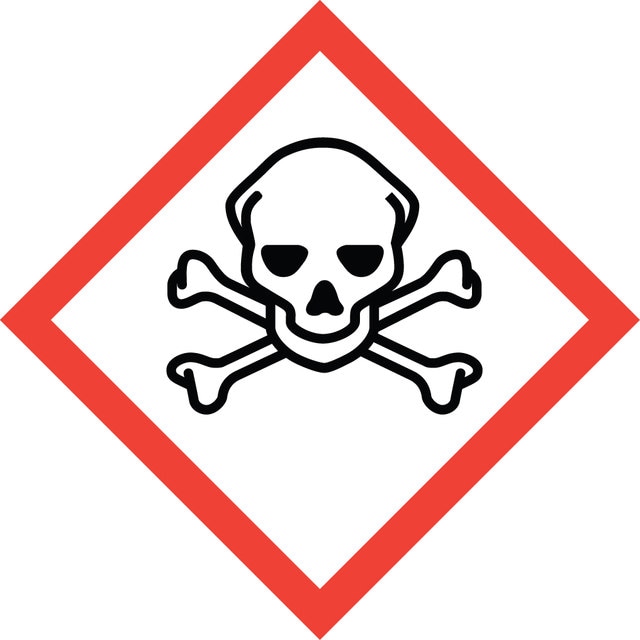登录 查看公司和协议定价
选择尺寸
关于此项目
经验公式(希尔记法):
C20H17ClN4O3
化学文摘社编号:
分子量:
396.83
MDL编号:
UNSPSC代码:
12352202
PubChem化学物质编号:
NACRES:
NA.77
质量水平
方案
≥98% (HPLC)
表单
solid
颜色
brown
溶解性
H2O: insoluble <2 mg/mL
DMSO: >5 mg/mL
储存温度
2-8°C
SMILES字符串
[O-][N+](=O)c1ccc(N2CCN(CC2)C(=O)c3ccc(Cl)cc3)c4cccnc14
InChI
1S/C20H17ClN4O3/c21-15-5-3-14(4-6-15)20(26)24-12-10-23(11-13-24)17-7-8-18(25(27)28)19-16(17)2-1-9-22-19/h1-9H,10-13H2
InChI key
KLNPVNZJCWIQSK-UHFFFAOYSA-N
生化/生理作用
CPNQ is a promoter of polyQ and α-synuclein inclusion formation and rescuer of Htt proteosomal dysfunction and α-synuclein toxicity.
Misfolded proteins accumulate in many neurodegenerative diseases, including huntingtin in Huntington′s disease and alpha-synuclein in Parkinson′s disease. The disease-causing proteins can take various conformations and are prone to aggregate and form larger cytoplasmic or nuclear inclusions. CPNQ (B2) was identified as a compound that promotes inclusion formation in cellular models of both Huntington′s disease and Parkinson′s disease. Despite the aggregate-forming specifics the compound prevents huntingtin-mediated proteasome dysfunction and reduces alpha-synuclein-mediated toxicity. These results demonstrate that compounds that increase inclusion formation may actually lessen cellular pathology in both Huntington′s and Parkinson′s diseases, suggesting a therapeutic approach for neurodegenerative diseases caused by protein misfolding. The ability of B2 to prevent toxicity, despite increasing inclusions, suggests that inclusions are beneficial rather than toxic, which will be further explored as the molecular target and mechanism. CPNQ (B2) is a desirable tool for both Huntington′s and Parkinson′s research.
其他说明
Product is air sensitive.
警示用语:
Danger
危险分类
Acute Tox. 3 Oral - Eye Irrit. 2 - Skin Irrit. 2 - STOT SE 3
靶器官
Respiratory system
储存分类代码
6.1C - Combustible acute toxic Cat.3 / toxic compounds or compounds which causing chronic effects
WGK
WGK 3
闪点(°F)
Not applicable
闪点(°C)
Not applicable
个人防护装备
Eyeshields, Faceshields, Gloves, type P2 (EN 143) respirator cartridges
法规信息
新产品
此项目有
Xiaofen Liu et al.
The Journal of infection, 82(2), 207-215 (2021-01-17)
Polymyxin B is a last-line antibiotic for multidrug-resistant gram-negative bacterial infections. However, limited safety and pharmacokinetic information is available. We investigated the safety and pharmacokinetics of intravenous polymyxin B in healthy subjects. An open-label, single-dose clinical trial was conducted in
Muralidhar Tata et al.
PloS one, 11(1), e0147811-e0147811 (2016-01-29)
The opportunistic human pathogen Pseudomonas aeruginosa can thrive under microaerophilic to anaerobic conditions in the lungs of cystic fibrosis patients. RNASeq based comparative RNA profiling of the clinical isolate PA14 cultured in synthetic cystic fibrosis medium was performed after planktonic
Edin Husić et al.
Bioinformatics (Oxford, England), 35(5), 769-777 (2018-08-14)
Discovering the evolution of a tumor may help identify driver mutations and provide a more comprehensive view on the history of the tumor. Recent studies have tackled this problem using multiple samples sequenced from a tumor, and due to clinical
Krin S Mann et al.
Virology, 476, 413-418 (2015-01-16)
RNA silencing in plants and insects provides an antiviral defense and as a countermeasure most viruses encode RNA silencing suppressors (RSS). For the family Rhabdoviridae, no detailed functional RSS studies have been reported in plant hosts and insect vectors. In
Chantal M Ferguson et al.
Molecular therapy. Nucleic acids, 21, 384-393 (2020-07-11)
RNA interference (RNAi) is a potent mechanism that silences mRNA and protein expression in all cells and tissue types. RNAi is known to exert many of its functional effects in the cytoplasm, and thus, the cellular localization of target mRNA
我们的科学家团队拥有各种研究领域经验,包括生命科学、材料科学、化学合成、色谱、分析及许多其他领域.
联系客户支持